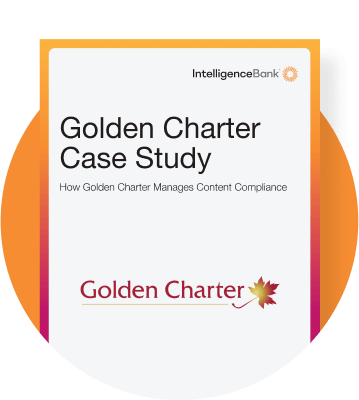Establishing a culture of compliance within your marketing strategies and initiatives requires more than just good intentions or an annual meeting between marketing and compliance teams. It demands a full commitment from the entire organization. Given the potential for hefty fines and other serious consequences for non-compliance, cultivating this culture is a vital task for any business.
A culture of compliance means creating an environment where compliance isn’t just a box to check but is embedded into every aspect of your organization’s work, from core values and business practices to everyday ethical behavior. Below are six key steps to help your team foster a marketing compliance culture that sticks—and solutions to make the process smoother.
Step 1. Lead from the Top Down
To create a thriving compliance culture, leadership has to set the tone. This involves active participation from C-level executives who must hold themselves accountable and lead by example. A strong culture of compliance isn’t possible unless it is championed from the top.
Executives play a pivotal role in shaping corporate values, and their attitudes toward compliance trickle down through every level of the company. When senior leaders are actively involved in compliance, it sends a powerful message about its importance. Their commitment helps normalize compliance discussions and elevates its role in decision-making processes.
Encourage senior management to be transparent about their own regulatory compliance experiences during meetings. This openness fosters a sense of community and mutual understanding of the risks associated with non-compliance. When executives share their challenges and solutions, it helps break down barriers and build a compliance-first mindset across the organization.
To reinforce the culture, it’s essential that compliance behaviors are recognized and rewarded, just like any other key performance indicator. This consistency across messaging and actions highlights the significance of compliance throughout the company.
Solution: Investing in marketing compliance tools like IntelligenceBank helps leaders stay in the loop and quickly adjust their compliance strategies when needed. With automated workflows and AI-powered compliance checks, IntelligenceBank gives teams the visibility they need to spot and address potential issues in real time.

Step 2. Invest in Ongoing Training
Training is the backbone of any strong culture of compliance. High-quality, ongoing training ensures that compliance remains top of mind for employees, providing the most current regulatory information and keeping teams aware of potential risks. Annual training is simply not enough—rules and regulations evolve constantly, and so should your team’s knowledge.
Effective training not only helps employees understand the technical aspects of compliance but also empowers them to make informed decisions in real-world situations. Incorporate interactive elements into your training, such as quizzes, workshops, or case studies. Engaging with real scenarios helps employees see how compliance plays out in their day-to-day tasks.
Tailor your training to real, industry-specific challenges. For example, in financial services, marketing teams could examine compliance risks related to investment opportunity disclaimers. In doing so, they can apply up-to-date regulations from governing bodies like FINRA or the FCA. Addressing both clear-cut cases and gray areas helps teams develop a nuanced understanding of compliance issues.
After each session, collect feedback and continuously improve your training process. The goal is to create engaging and practical learning experiences that resonate with your team.
Solution: Using AI-powered platforms like IntelligenceBank can enhance training by offering real-time compliance risk detection during daily tasks. This helps employees immediately see and correct potential mistakes, further embedding compliance into their workflow.
Step 3. Set Clear and Accessible Procedures
For a culture of compliance to thrive, your team must have clear, specific guidelines and procedures. These protocols help set the right expectations and provide a reference point when questions arise.
Setting up easily accessible procedures not only ensures consistency but also boosts efficiency. When employees have instant access to the latest guidelines, they’re more likely to make compliant decisions, avoiding errors that come from guesswork or outdated information. Centralized documentation should be viewed as a living resource—updated frequently and clearly communicated to everyone involved.
It’s crucial to centralize these procedures in an easily accessible location. Regularly updating these documents and informing your team about changes ensures that everyone is aligned.
Formal training is key, but you should also encourage informal compliance discussions. Normalizing conversations about compliance creates a more open atmosphere, where team members can seek guidance or clarification without hesitation.
Solution: IntelligenceBank’s marketing operations and compliance platform can centralize documentation and provide real-time updates to your marketing and compliance teams. This solution ensures everyone is working with the most current information, reducing the risk of outdated compliance practices. It also means there is one set of policies and procedures for all departments.
Step 4. Keep Communication Open Between Departments
Strong communication between marketing, compliance, and legal teams is essential to minimizing compliance risks. These departments may have different priorities, but a culture of compliance requires that they work together toward a common goal. When marketing and compliance teams are in sync, campaigns are both creative and compliant, reducing the risk of rework or delays.
Regular interdepartmental meetings allow teams to align on goals and ensure that compliance is part of the broader marketing strategy. During these sessions, encourage open dialogue to discuss upcoming marketing initiatives and identify potential compliance risks before they escalate.
By fostering transparency and collaboration, these meetings also help to prevent friction and delays in the review process. The result is a more efficient, productive relationship between departments, with fewer bottlenecks in the marketing review and approval process.
Solution: Leverage IntelligenceBank’s AI-powered risk detection to speed up the review process. By flagging potential compliance risks in marketing content, the tool helps compliance and marketing teams collaborate more effectively and reduce manual review time.
Step 5. Measure the Effectiveness of Your Compliance Culture
You can’t manage what you can’t measure, and this applies to building a culture of compliance as well. While compliance may seem difficult to quantify, key metrics can help gauge the success of your program.
Look beyond the obvious metrics like compliance incidents or violations. Consider qualitative measures such as employee feedback, the level of engagement during compliance training, or how often employees seek guidance from the compliance team. The more employees engage with compliance proactively, the healthier your compliance culture is.
Consider metrics like feedback from employees, the number of compliance incidents before and after training, and post-training quiz scores to track retention. These metrics will provide valuable insight into how well your team is adopting compliance practices.
Solution: IntelligenceBank’s dashboards offer detailed analytics, allowing you to track compliance performance over time. By keeping all data in one place, you can easily spot trends, address gaps, and continuously improve your compliance efforts.
Step 6. Cultivate a Team of Happy Employees
Ultimately, a healthy culture of compliance depends on engaged and motivated employees. Teams should want to comply with regulations not out of fear, but because they understand the value it brings to the company. Creating a positive work environment, listening to employee needs, and providing incentives for good compliance behavior helps cultivate this mindset. It should be something everyone in the organization should be proud of.
When mistakes happen, it’s important to look at the root cause. Sometimes the problem may have stemmed from unclear protocols rather than a lack of awareness or sloppy work. Use mistakes as learning opportunities to improve your processes, and your team will feel supported rather than punished.
Solution: Promote a collaborative, proactive approach and provide staff with the training and tools to confidently navigate compliance requirements. By equipping your team with the right resources—like AI-powered platforms and real-time risk detection tools—they’ll be able to make informed decisions and identify potential issues before they become problems. This not only builds trust but ensures compliance becomes a seamless part of their daily work.
Maintain Your Culture of Compliance with Continuous Improvement
A culture of compliance is not a one-and-done effort—it requires ongoing attention and care. By investing in continuous improvement, you ensure that compliance remains a core part of your company’s DNA.
Choosing the right compliance solution is key.
IntelligenceBank simplifies the process by providing AI-powered tools that bridge the gap between marketing, compliance, and legal teams. Our custom risk detection analyzes marketing copy for risky content in just a few clicks, speeding up reviews and approvals.
Ready to build a strong culture of compliance? Contact us for a demo, we’d love to hear from you.




